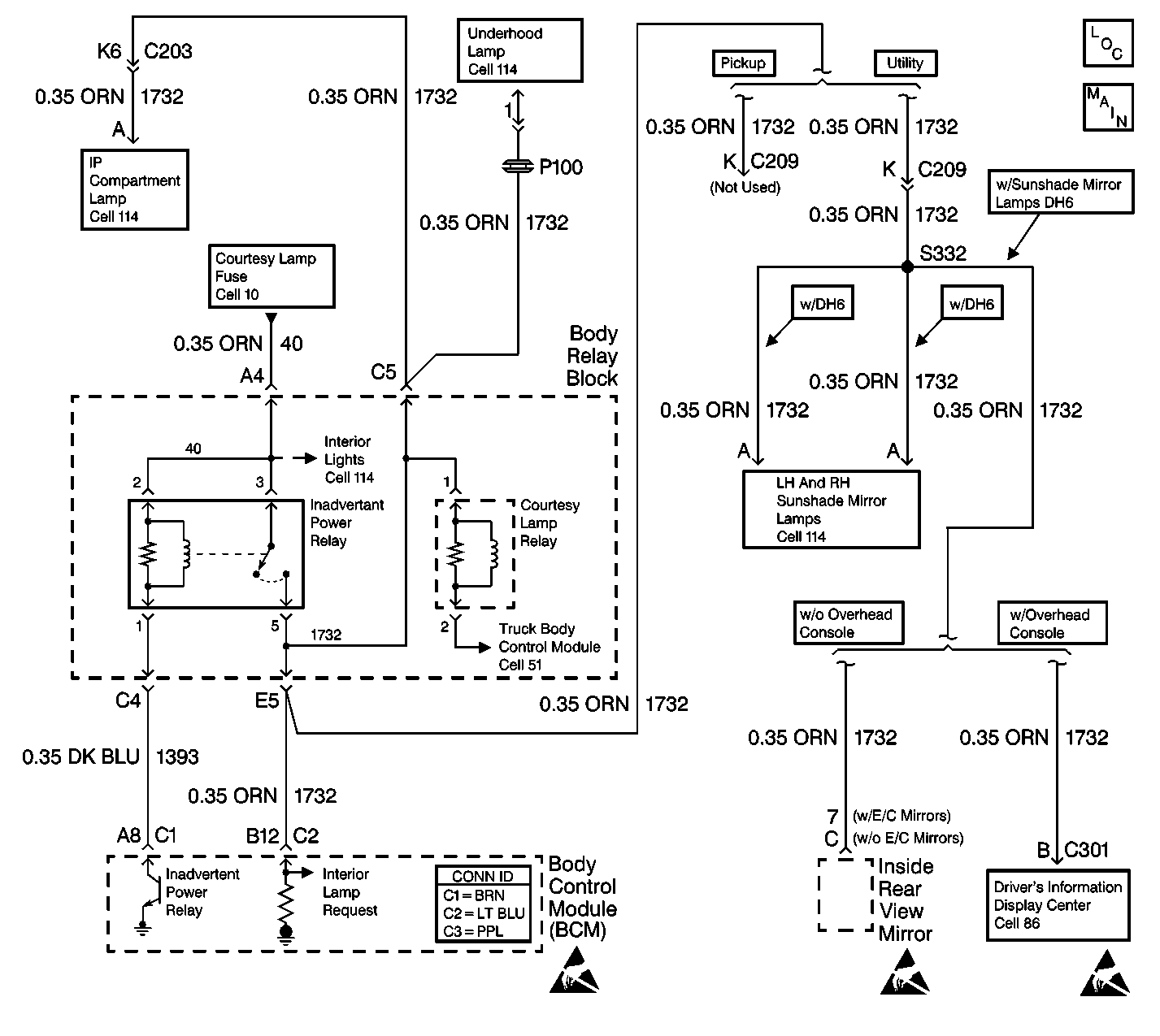
Circuit Description
When the ignition switch has been in the OFF position for 20 minutes the BCM battery rundown protection function disables the following items:
| • | The courtesy lamps |
| • | The cargo lamps |
| • | The underhood lamp |
The BCM monitors the output of the inadvertent power relay on CKT 1732.
DTC B1480 will set when the following conditions exist:
| • | The BCM turns the relay ON. |
| • | The BCM does not detect voltage on CKT 1732. |
Conditions for Setting the DTC
| • | DTC B1480 will set if the voltage on CKT 1732 is low when the BCM is commanding the relay control circuit to energize the inadvertent power relay. |
| • | The system voltage is between 9.0-16.0 volts. |
| • | The above conditions exist for 0.5 seconds. |
Action Taken When the DTC Sets
The following lamps will be disabled:
| • | The dome lamp |
| • | The glove box lamp |
| • | The reading lamps |
| • | The under hood lamp |
| • | The vanity lamps |
Conditions for Clearing the MIL/DTC
| • | DTC B1480 will clear immediately after the condition that sets the DTC is corrected. |
| • | A history DTC will clear after 100 consecutive ignition cycles without a fault present. |
| • | History and current DTCs may be cleared using a scan tool. |
Diagnostic Aids
| Important: Use the appropriate probe from the J 35616 connector test adapter kit for any probing of the fuse blocks or relay blocks in this table. Use of the appropriate probe prevents damage to the fuse blocks or relay blocks. |
| • | Always diagnose the first DTC that is listed on the scan tool. |
| • | Verify that the scan tool displays DTC B1480 as a current code before you perform diagnostics. |
| • | Inspect for loose or poor connections at all of the related components. |
| • | Refer to Intermittents and Poor Connections Diagnosis in Wiring Systems. |
Test Description
The numbers below refer to the step numbers on the diagnostic table.
-
This step tests the CTSY LP fuse.
-
This step determines if one of the following conditions exists:
-
This step determines if the BCM is able to control the inadvertent power relay.
-
This step determines if one of the following conditions exists:
-
This step determines if CKT 40 is open.
-
This step determines if CKT 1393 is open between the inadvertent power relay and the BCM.
-
This step determines if CKT 1732 is open between the inadvertent power relay and the BCM.
| • | A short to ground on CKT 40 or CKT 1732 |
| • | An open circuit in the underhood fuse block |
| • | CKT 1732 is open. |
| • | The BCM is unable to monitor voltage on CKT 1732. |
Step | Action | Value(s) | Yes | No |
|---|---|---|---|---|
1 | Did you perform the BCM Diagnostic System Check? | -- | Go to Step 2 | |
Use a test lamp in order to test both sides of the CTSY fuse to ground. Does the test lamp light on both sides of the fuse? | -- | Go to Step 6 | Go to Step 3 | |
Does the test lamp light on one side of the fuse? | -- | Go to Step 4 | Go to Step 5 | |
4 |
Is the repair complete? | -- | Go to Step 16 | -- |
5 | Replace the underhood fuse block. Is the repair complete? | -- | Go to Step 16 | -- |
Does the scan tool display DTC B1480? | -- | Go to Step 7 | Go to Step 15 | |
Does the J 39200 DMM display battery voltage? | -- | Go to Step 15 | Go to Step 8 | |
Does the J 39200 DMM display battery voltage at both of the cavities? | -- | Go to Step 9 | Go to Step 13 | |
Is the resistance within the specified range? | 0-5 ohms | Go to Step 10 | Go to Step 12 | |
Is the resistance within the specified range? | 0-5 ohms | Go to Step 14 | Go to Step 11 | |
11 | Locate and repair the open in CKT 1393 (DK BLU) between the BCM and the body relay block. Is the repair complete? | -- | Go to Step 16 | -- |
12 | Locate and repair the open in CKT 1732 (ORN) between the BCM and the body relay block. Is the repair complete? | -- | Go to Step 16 | -- |
13 | Locate and repair the open in CKT 40 (ORN) between the inadvertent power relay and the underhood fuse block. Is the repair complete? | -- | Go to Step 16 | -- |
14 | Replace the inadvertent power relay. Is the repair complete? | -- | Go to Step 16 | -- |
15 |
Is the repair complete? | -- | Go to Step 16 | -- |
16 | Clear the DTCs. Is the repair complete? | -- | -- |
